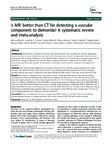Is MRI better than CT for detecting a vascular component to dementia? A systematic review and meta-analysis
| dc.contributor.author | Beynon, R | |
| dc.contributor.author | Sterne, JAC | |
| dc.contributor.author | Wilcock, G | |
| dc.contributor.author | Likeman, M | |
| dc.contributor.author | Harbord, RM | |
| dc.contributor.author | Astin, M | |
| dc.contributor.author | Burke, M | |
| dc.contributor.author | Norman, Alyson | |
| dc.contributor.author | Ben-Shlomo, Y | |
| dc.contributor.author | Hawkins, J | |
| dc.contributor.author | Hollingworth, W | |
| dc.contributor.author | Whiting, P | |
| dc.date.accessioned | 2014-10-27T14:39:15Z | |
| dc.date.available | 2014-10-27T14:39:15Z | |
| dc.date.issued | 2012-12 | |
| dc.identifier.issn | 1471-2377 | |
| dc.identifier.issn | 1471-2377 | |
| dc.identifier.other | 33 | |
| dc.identifier.uri | http://hdl.handle.net/10026.1/3148 | |
| dc.description.abstract |
<jats:title>Abstract</jats:title> <jats:sec> <jats:title>Background</jats:title> <jats:p>Identification of causes of dementia soon after symptom onset is important, because appropriate treatment of some causes of dementia can slow or halt its progression or enable symptomatic treatment where appropriate. The accuracy of MRI and CT, and whether MRI is superior to CT, in detecting a vascular component to dementia in autopsy confirmed and clinical cohorts of patients with VaD, combined AD and VaD (“mixed dementia”), and AD remain unclear. We conducted a systematic review and meta-analysis to investigate this question.</jats:p> </jats:sec> <jats:sec> <jats:title>Methods</jats:title> <jats:p>We searched eight databases and screened reference lists to identify studies addressing the review question. We assessed study quality using QUADAS. We estimated summary diagnostic accuracy according to imaging finding, and ratios of diagnostic odds ratios (RDORs) for MRI versus CT and high versus low risk of bias.</jats:p> </jats:sec> <jats:sec> <jats:title>Results</jats:title> <jats:p>We included 7 autopsy and 31 non-autopsy studies. There was little evidence that selective patient enrolment and risk of incorporation bias impacted on diagnostic accuracy (p = 0.12 to 0.95). The most widely reported imaging finding was white matter hyperintensities. For CT (11 studies) summary sensitivity and specificity were 71% (95% CI 53%-85%) and 55% (44%-66%). Corresponding figures for MRI (6 studies) were 95% (87%-98%) and 26% (12%-50%). General infarcts was the most specific imaging finding on MRI (96%; 95% CI 94%-97%) and CT (96%; 93%-98%). However, sensitivity was low for both MRI (53%; 36%-70%) and CT (52%; 22% to 80%). No imaging finding had consistently high sensitivity. Based on non-autopsy studies, MRI was more accurate than CT for six of seven imaging findings, but confidence intervals were wide.</jats:p> </jats:sec> <jats:sec> <jats:title>Conclusion</jats:title> <jats:p>There is insufficient evidence to suggest that MRI is superior to CT with respect to identifying cerebrovascular changes in autopsy-confirmed and clinical cohorts of VaD, AD, and ‘mixed dementia’.</jats:p> </jats:sec> | |
| dc.format.extent | 33- | |
| dc.format.medium | Electronic | |
| dc.language | en | |
| dc.language.iso | eng | |
| dc.publisher | Springer Science and Business Media LLC | |
| dc.subject | Dementia | |
| dc.subject | CT | |
| dc.subject | MRI | |
| dc.subject | Diagnosis | |
| dc.subject | Systematic review | |
| dc.title | Is MRI better than CT for detecting a vascular component to dementia? A systematic review and meta-analysis | |
| dc.type | journal-article | |
| dc.type | Journal Article | |
| dc.type | Meta-Analysis | |
| dc.type | Research Support, Non-U.S. Gov't | |
| dc.type | Review | |
| dc.type | Systematic Review | |
| plymouth.author-url | https://www.webofscience.com/api/gateway?GWVersion=2&SrcApp=PARTNER_APP&SrcAuth=LinksAMR&KeyUT=WOS:000306755600001&DestLinkType=FullRecord&DestApp=ALL_WOS&UsrCustomerID=11bb513d99f797142bcfeffcc58ea008 | |
| plymouth.issue | 1 | |
| plymouth.volume | 12 | |
| plymouth.publication-status | Published | |
| plymouth.journal | BMC Neurology | |
| dc.identifier.doi | 10.1186/1471-2377-12-33 | |
| plymouth.organisational-group | /Plymouth | |
| plymouth.organisational-group | /Plymouth/Faculty of Health | |
| plymouth.organisational-group | /Plymouth/Faculty of Health/School of Psychology | |
| plymouth.organisational-group | /Plymouth/REF 2021 Researchers by UoA | |
| plymouth.organisational-group | /Plymouth/REF 2021 Researchers by UoA/UoA04 Psychology, Psychiatry and Neuroscience | |
| plymouth.organisational-group | /Plymouth/Research Groups | |
| plymouth.organisational-group | /Plymouth/Research Groups/Centre for Brain, Cognition and Behaviour (CBCB) | |
| plymouth.organisational-group | /Plymouth/Research Groups/Centre for Brain, Cognition and Behaviour (CBCB)/Behaviour | |
| plymouth.organisational-group | /Plymouth/Users by role | |
| plymouth.organisational-group | /Plymouth/Users by role/Academics | |
| dc.publisher.place | England | |
| dcterms.dateAccepted | 2012-06-06 | |
| dc.identifier.eissn | 1471-2377 | |
| dc.rights.embargoperiod | Not known | |
| rioxxterms.versionofrecord | 10.1186/1471-2377-12-33 | |
| rioxxterms.licenseref.uri | http://www.rioxx.net/licenses/all-rights-reserved | |
| rioxxterms.licenseref.startdate | 2012-06-06 | |
| rioxxterms.type | Journal Article/Review |


